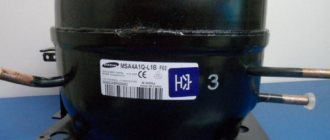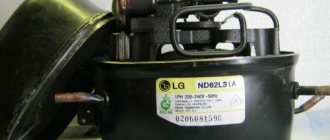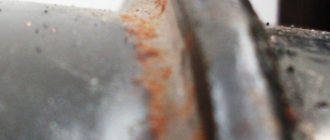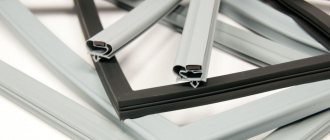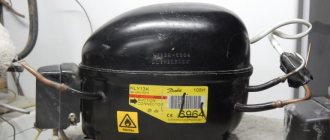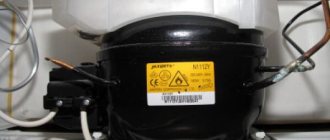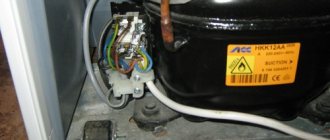Obviously, one of the most important items in any kitchen is the refrigerator. Surely many remember what careful care it was subjected to before: the refrigerator had to be defrosted periodically so that too large an ice layer did not form on its back wall, it was necessary to wash it quite often and monitor every incomprehensible sound, because any strange sound could mean an impending breakdown.
Nowadays, the situation has, of course, changed somewhat. Thanks to modern cooling systems, there is no longer a need for defrosting, you don’t need to wash the refrigerator so often, and it doesn’t make any extraneous sounds, but then and now you can monitor its condition by another sign: heating of the compressor. But to what temperature does the refrigerator compressor heat up? How to determine the norm?
Compressor operating principle
In order to understand what heating temperature is critical for a compressor, it is worth understanding its operating principle.
During operation, a fairly high compressor temperature is normal. Its values can reach 60 degrees Celsius, with increased load – up to 90 degrees. The reason for this heating is that during operation this part is subjected to fairly high loads.
The low temperature in the refrigerator is ensured due to the chemical properties of freon or its analogues. The flow of this substance enters the compressor, which, in turn, compresses the freon and directs it to the condenser. Next, the freon is cooled in the condenser, turning into a liquid state. Liquid freon is sent further through the cooling system, eventually returning to the compressor in a gaseous state.
The compressor operates periodically: the quiet period and the operating period are determined. Active work occurs until the required temperature is reached. That is why, when you turn on the refrigerator for the first time, it is not recommended to load it with warm food. Some refrigerators are equipped with a mechanism that allows you to turn off the compressor, thereby ensuring a longer life of the refrigerator.
What to do if the compressor overheats
If the refrigerator compressor is hot, but the device continues to work, you need to check all the elements.
Diagnostics:
- Measure the temperature in the refrigerator and freezer.
- Inspect the supercharger. It is difficult to get to it, since the device is closed with a protective casing filled with oil. The design of most units is the same. The main parts are the starting relay and the electric motor. The main sign of a motor malfunction is a damaged winding. To check the relay, you need to inspect the terminals, having first removed it from its place.
- Often the refrigerator does not work normally due to damage to the power cord. You need to carefully inspect the wire and plug. A faulty cable is the simplest malfunction of the device.
- Need to check the resistance. To do this, select an area on the body without enamel. A multimeter is attached to it. If there is no suitable place, you will have to scrape the paint off the body. The multimeter screen should not display readings. If the device transmits any data, then the refrigerator may give an electric shock.
- Checking the current supply. To do this you will need a multimeter and a working relay. A 140 W motor produces a current of 1.3 A. This ratio of parameters does not change when the power of the device changes.
Recommendations:
- Check that the distance from the grille to the wall is 15 cm.
- You can adjust the height of the legs to level the position of the refrigerator relative to the floor.
- Defrost the refrigerator, remove food from all chambers. When loading, follow the rules for placing products.
- Check the quality of the temperature sensor with a multimeter.
If these tips do not work, you will have to install a new compressor.
Replacement rules:
- All food, shelves and storage containers are removed from the cells. The equipment turns off and turns around. The compressor in the refrigerator is located in a specially designated niche at the bottom. The part is lifted, the tubes carrying the refrigerant are bent. The motor then moves forward. This procedure requires care.
- The charging tube is broken to remove all the freon from the system. The broken edge of the tube is pinched and the blower is started for 5-10 minutes so that the refrigerant enters the condenser.
- A piercing valve is then installed on the dryer. The hose from it leads to the cylinder. The valve opens and all freon is removed from the system.
- In place of the broken tube, a copper plate 0.6 mm thick and 6 cm long is placed. A tight connection is created with a blowtorch.
- All tubes are removed from the engine, cleaned and closed with plugs.
- The new compressor is being prepared for installation. The plugs are removed from the tubes, all pipes are connected to the cooling system. A filter drier is installed on the condenser, then a capillary tube is inserted. All connections are soldered. There should be no recesses or protrusions at the joints.
After installation, you need to start the refrigerator and check the quality of its operation.
Important! Mistakes made during the installation of a new compressor lead to depressurization and leakage of fuel. This affects the performance of the device. Therefore, it is not recommended to replace it yourself.
Hot sides of the refrigerator
If the sides of the refrigerator heat up, and not the back, there is no need to sound the alarm either. It is better to become familiar with the mechanics of the device of a particular model, because the network of tubes that provides cooling can be located on the sides, that is, in the side walls. And since this does not change the mechanics of operation and the compressor also heats up during operation, the walls where the cooling system is located also heat up.
However, if the compression unit is located on the back wall of the refrigerator, this may be an alarming signal and indicate a problem.
The influence of external factors should also not be excluded. So, if the refrigerator is located near an oven or stove, the sides may heat up under the thermal influence of these appliances. Such exposure can negatively affect the performance of the refrigerator, so placing these items nearby should be avoided.
Should the compressor and motor in the refrigerator be hot?
Obviously, the compressor performs a rather complex function, which is why heating occurs. Indeed, in order to achieve the required state of aggregation of the coolant, very high pressure has to be applied. In addition, the coolant transfers a certain amount of thermal energy.
As for the refrigerator motor, it is also normal to heat up. To operate a refrigerator, it is necessary to generate a sufficiently large amount of electric current, which entails heating.
But don't forget that excessive heat is not normal. And if suspicions arise about this, then it is better to measure the temperature of these elements.
Compressor operation and normal heating
In a classic refrigerator, a compressor unit that absorbs freon from the evaporation chamber, filters it and redirects it to the condenser. In this case, significant heating of the gas occurs. Cooling down in the condenser, freon again acquires a liquid state of aggregation, cools the unit and then becomes a gas again, returning through the evaporation chamber to the condenser. This process is repeated until the temperature set by the thermostat is reached.
Why does the refrigerator get very hot and how to fix it
Why does the refrigerator body heat up: causes of the problem
The refrigerator is not cooling, but the freezer is working: what to do?
That is, the compressor needs to operate in virtually extreme conditions. So that the temperature in the refrigerator compartment is +5 ̊C, and in the freezer – -18...-20 ̊C, the compressor needs to compress the freon at significant pressure. The compressed refrigerant heats up very much and transfers part of this temperature to the compressor, and leaves the rest in a specialized lattice heat exchanger.
Reference! The lattice heat exchanger also absorbs the temperature that is emitted by the electric current as it passes through the compressor windings.
In operating condition, according to technical standards, the compressor temperature is in the range of +50...+60 ̊С, higher heating is acceptable, but not higher than +90 ̊С. An exception is the compressor of a refrigeration unit, which has worked for more than a decade - its temperature can be slightly higher than +90 ̊C.
How hot can a compressor get?
The heating of the compressor depends on the load on the refrigerator. Loads both external and internal. A normal temperature is 60 degrees Celsius. But in the case of a hot season or when placing hot foods in the refrigerator, it can rise to 90 degrees.
The greater the load on the cooling system, the higher the temperature. But it is worth noting that if there is no increased load, and the compressor temperature remains at high values for a long time, this is a cause for concern. After all, this is the surest sign that the device is not working correctly.
Refrigeration equipment heats, not freezes
The motor heats up both in working refrigerators and in refrigerators with malfunctions. You should start worrying only when the temperature in the chambers begins to rise or fall, that is, the food spoils or gets frozen. When the engine heats up and does not freeze, the following may be provoking factors:
- refrigerant leak;
- temperature sensor malfunction;
- clogged filter drier or capillary system;
- violation of heat transfer from the walls of a room with high temperatures and humidity.
When gas is released from the circuit, the compressor operates continuously, without interruption, compressing air. In this situation, it is not surprising that the compressor gets very hot. The engine is so hot that if you touch it, you can get burned. The evaporator takes over the temperature and also heats up.
When the engine does not start, you need to look for the cause in the compressor. Most often, an interturn circuit or short circuit occurs. The result is heating of the motor, and you can hear the clicks of the start-up relay, which is activated.
Attention! To solve the problem, it will be necessary to replace the unit, which is expensive.
When the capillary is clogged, the freezer will heat up. A symptom of a breakdown is heating of only the first leg of the condenser grid, and the rest of the unit is at normal temperature (cool). A breakdown of the temperature control sensor or an electronics failure can also stop the compressor from starting; in these cases, the unit does not receive a start command. Thus, a broken ECU does not transmit a control signal, and the temperature sensor erroneously transmits to the ECU information that the temperature in the chambers is normal, which leads to the ECU not sending a signal.
There are reasons that are not malfunctions in the operation of refrigeration equipment, but can lead to an increase in temperature in the chambers. These factors include the following:
- an excessive volume of products is loaded into the chambers;
- containers with hot contents are placed in the refrigerator;
- doors open excessively;
- The refrigerator has not been defrosted for a long time.
The above is a violation of the operating standards of the refrigeration cabinet, which gradually leads to accelerated wear and tear of household appliances.
Video: the compressor is very hot and there is no cold
Why is the refrigerator compressor hot?
If we talk specifically about compressor overheating, there are several reasons that lead to this:
- Deformation or damage to the heat exchanger.
- Activation of the deep freezing function, which entails long-term continuous operation of the compression unit.
- Setting the refrigerator temperature too low, requiring the compressor to work harder to maintain it.
- Placing a large amount of warm or hot food in the refrigerator causes the refrigerator temperature to rise.
- Thermal influence of the environment, for example, nearby ovens, stoves.
- The door is not tightly closed. Air from outside continuously enters the refrigerator, which leads to an increase in temperature and, as a result, an increase in the load on the compressor.
- Frequent opening of the refrigerator. Just as in the case of a door that is not tightly closed, the temperature increases due to the entry of warm air.
- A malfunction of the temperature sensor, which leads to non-stop operation, regardless of the temperature in the refrigerator.
- Ignoring defrosting rules. Too much ice has a negative impact on the cooling system.
- Wear of cooling system elements.
- Damage to the tubes through which the coolant moves.
In the case of a compressor failure, you can observe the following:
- the compressor turns on and immediately turns off;
- warm or hot air enters the refrigerator;
- an ice cap forms faster in the refrigerator compartment;
- upon contact, the walls of the refrigerator receive an electric shock;
- condensation appears.
Reasons why the compressor runs non-stop
One of the most common reasons why a refrigerator compressor overheats is not directly related to its malfunction. Overheating is possible with prolonged continuous operation of the motor. This mode leads to increased energy costs and accelerates wear on the refrigerator compressor. Therefore, it is important to quickly identify and eliminate the cause.
Most often, an increase in the duration of the active mode is associated with a violation of the requirements for the operation of refrigeration equipment, for example, if users:
- place hot products in the chamber;
- leave the door open for a long time;
- the refrigerator is not defrosted in a timely manner if defrosting is recommended by the manufacturer;
- The temperature regulator is set to the maximum position, the emergency freezing function is always set;
- the requirements for installing the refrigerator are violated - it is located too close to the wall or next to heating appliances;
- The household appliance is overloaded with products.
As a result of such violations, the device chamber heats up or the cooling efficiency deteriorates. As a result, the compressor operates at increased efficiency, which causes it to become overheated. This may cause a breakdown in the future. Therefore, to increase the service life and increase the efficiency of household appliances, it is recommended to follow the operating mode recommended by the manufacturer.
In addition to operational violations, prolonged continuous operation of the compressor motor can be caused by malfunctions of other elements and components of the refrigerator.
One of the common causes is wear of the seal, which compromises the tightness of the chamber. The entry of warm air into it leads to frequent starts and longer operation of the motor.
Failure of the temperature sensor can also lead to disruption of the operating mode of the compressor device. If there is a malfunction, the sensor does not provide accurate temperature control, but gives erroneous signals to turn on. As a result, the unit can operate practically without shutdowns.
Depressurization of the system and leakage of freon disrupts its circulation. As a result, the engine runs continuously, under intense loads. This causes it to overheat and can quickly lead to failure.
